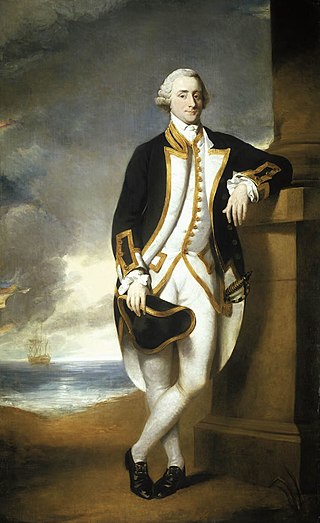
Admiral Sir Hugh Palliser, 1st Baronet was a Royal Navy officer. As captain of the 58-gun HMS Eagle he engaged and defeated the French 50-gun Duc d'Aquitain off Ushant in May 1757 during the Seven Years' War. He went on to serve as Commodore Governor of Newfoundland, then Controller of the Navy and then First Naval Lord. During the American Revolutionary War he came into a famous dispute with Augustus Keppel over his conduct as third-in-command of the Channel Fleet at the inconclusive Battle of Ushant in July 1778; the dispute led to Palliser being court-martialled, although he was subsequently acquitted. In retirement Palliser became Governor of Greenwich Hospital.

Sir Edward Knatchbull, 9th Baronet, was a British Tory politician. He held office under Sir Robert Peel as Paymaster of the Forces between 1834 and 1835 and as Paymaster General between 1841 and 1845.
Baron Keane, of Ghuznee in Afghanistan and of Cappoquin in the County of Waterford, was a title in the Peerage of the United Kingdom. It was created on 23 December 1839 for the military commander John Keane. He was the second son of Sir John Keane, 1st Baronet, of Cappoquin. The third Baron was a Lieutenant-General in the British Army. The title became extinct on his death in 1901.
Two baronetcies with the surname Arbuthnot have been created for members of the Arbuthnot family—both in the Baronetage of the United Kingdom, and still extant.

Sir William Arbuthnot, 1st Baronet of Edinburgh FRSE was a Scottish landowner and politician. He served as Lord Provost of Edinburgh and Lord Lieutenant of the City of Edinburgh.

Admiral Sir Alexander Dundas Young Arbuthnott was a British Royal Navy officer of the Victorian era.

Sir Robert Keith Arbuthnot, 2nd Baronet was a Scottish civil servant who served as Secretary to the Board of Trustees and Manufactures.

The Cradock-Hartopp Baronetcy, of Freathby in the County of Leicester and of Four Oaks Hall in the County of Warwick, was a title in the Baronetage of Great Britain. It was created on 12 May 1796 for Edmund Cradock-Hartopp, Member of Parliament for Leicestershire. Born Edmund Bunney, he was the husband of Anne Hurlock, granddaughter and heiress of Sir John Hartopp, 4th Baronet, of Freathby. On his marriage in 1777 he assumed the surname of Cradock-Hartopp in lieu of his patronymic according to the wills of his uncle Joseph Cradock and his wife's grandfather. His eldest surviving son Edmund, the second Baronet, died childless and was succeeded by his younger brother, William, the third Baronet. The title then descended from father to son until the death of his grandson, Charles, the fifth Baronet, in 1929.
The Bridges Baronetcy, of Goodnestone in the County of Kent, was created in the Baronetage of Great Britain on 19 April 1718 for Brook Bridges. His son the second Baronet, died in 1733 whilst in office as High Sheriff of Kent. His grandson, the third Baronet, represented Kent in the House of Commons. In 1842, the fifth Baronet, unsuccessfully claimed the ancient barony of FitzWalter as a descendant of Mary, sister of the seventeenth Baron FitzWalter. He later sat as a Member of Parliament for Kent East. In 1868 he was created Baron FitzWalter, of Woodham Walter in the County of Essex, in the Peerage of the United Kingdom. However, the peerage became extinct on his death, while he was succeeded in the baronetcy by his younger brother, the sixth Baronet. On his death the title passed to his first cousin, the seventh Baronet. He was the son of Reverend Brook Henry Bridges, third son of the third Baronet. When he died this line of the family also failed and the title was passed on to his first cousin, the eighth Baronet. He was the son of Reverend Brook Edward Bridges, fourth son of the third Baronet. He never married and on his death in 1899 the baronetcy became extinct.

Sir Brook William Bridges, 3rd Baronet was a British baronet and Whig politician.
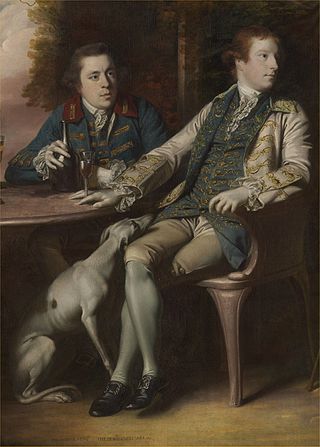
Henry Fane was a British politician who sat in the House of Commons for 30 years between 1772 and 1802.
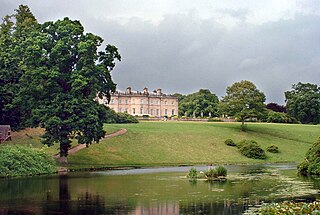
There have been four baronetcies created for persons with the surname Miller, two in the Baronetage of England, one in the Baronetage of Great Britain and one in the Baronetage of the United Kingdom. Two of the creations are extant as of 2008.
There have been two baronetcies created for persons with the surname Earle, one in the Baronetage of England and one in the Baronetage of the United Kingdom. One creation is extant as of 2007.
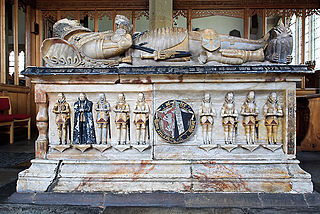
There have been two baronetcies created for members of the Salusbury family, the first in the Baronetage of England and the second in the Baronetage of Great Britain. Neither title has survived to the present day although the senior baronetcy is technically considered to be dormant.
The Revd. Sir Henry Thompson, 3rd Baronet Thompson of Virkees was the third son of Sir Charles Thompson, 1st Baronet, and Jane Selby. He succeeded to the baronetcy after his eldest brother the 2nd Baronet died without issue in 1826. On 26 February 1826 he married Hannah Jean Grey, third daughter of Sir George Grey, 1st Baronet, of Falloden, KCB, Commissioner at Portsmouth Dockyard, and Mary Whitbread, daughter of Samuel Whitbread. Sir George Grey was the third son of Charles Grey, 1st Earl Grey, and younger brother of Charles Grey, 2nd Earl Grey.

Thomas Taylour, 1st Marquess of Headfort, styled Viscount Headford from 1766 to 1795, and known as The Earl of Bective from 1795 to 1800, was an Irish peer and politician.
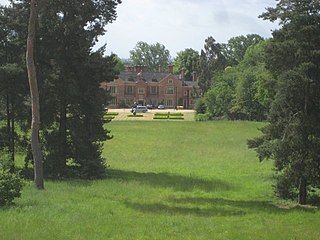
The Vache is an estate near Chalfont St Giles in Buckinghamshire, England. Located within the estate is a monument dedicated to the memory of Captain James Cook (1728–1779), the explorer. It has been owned or occupied by, among others, Hester and George Fleetwood, regicide of Charles I.
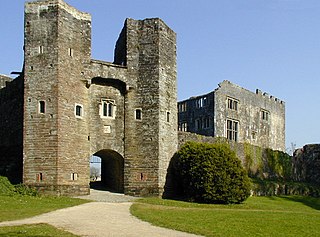
Sir Edward Seymour, 3rd Baronet of Berry Pomeroy Castle was an English politician who sat in the House of Commons at various times between 1640 and 1688. He fought for the Royalist cause in the English Civil War.

Sir Henry Paulet St John-Mildmay, 3rd Baronet, of Dogmersfield Park, Hampshire, was an English politician.

Sir Hugh Munro, 8th Baronet, born 25 October 1763, was a Scottish noble and also the chief of the Clan Munro, a Scottish clan of the Scottish Highlands. By tradition he was also the twenty-sixth Baron of Foulis. Before he died a dispute took place over the legitimacy of his daughter, resulting in a lawsuit.















